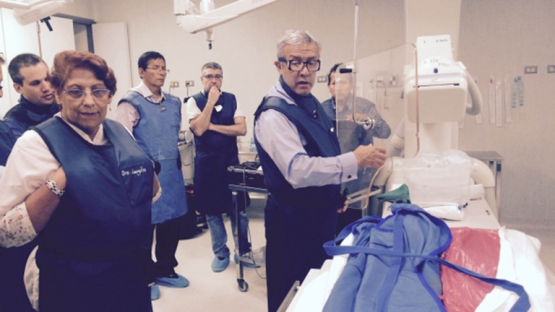A regional training course on radiation protection in interventional procedures for cardiologists and radiologists, including the prevention of radiation injuries, has taken place on 2-4 February 2015, organized by the International Atomic Energy Agency (IAEA) in collaboration with the Peruvian Institute for Nuclear Energy and the National Cardiovascular Institute of Peru.
Interventional procedures using x-rays are an alternative to more hazardous surgery and, for some types of diseases (including some that are life-threatening), they are the sole method of treatment. In addition, technological advances in imaging and ancillary equipment pave the way to new and more complex procedures, thus constantly expanding the field of application.
Along with their substantial benefits, interventional procedures lead to relatively high radiation doses. In most cases, a few minutes of fluoroscopy and a moderate number of image acquisitions are sufficient, but in some other cases, the pathology is complex, the access to the area of interest with catheters is difficult, and the procedure becomes a long intervention with a very high exposure, which is even higher if the patient is corpulent. In extreme cases, if radiation protection measures are not applied, a permanent and severe radiation injury with impairment to the patient's life quality has been observed. Radiation injuries are not only observed on patients, but also on the physicians who conduct these interventions, who experience increased incidence of radiation-induced eye lens opacities.
"Almost all of the severe injuries that have occurred, including those in the Latin American region, would have been avoidable, if relatively simple protective measures had been taken," says Pedro Ortiz, Technical Officer in the IAEA Department of Nuclear Safety and Security. The purpose of the training course was to teach professionals the methods that are available to reduce unnecessary exposure on patients and professionals.
The course took place as part of a regional technical cooperation project of the IAEA on Strengthening National Infrastructure for End-Users to Comply with Regulations and Radiological Protection Requirements1. Twenty-six interventional cardiologists and radiologists from Argentina, Bolivia, Costa Rica, Cuba, Ecuador, El Salvador, Honduras, Peru and Uruguay took part in a series of lectures on radiological equipment for x-ray image guided intervention, optimization of protection for patients and the professionals, and developing a programme of protection.
"By creating a group of cardiologists and radiologists in the Latin America region who are now trained, motivated, and committed to make advances in radiation protection through their praxis the course was a success", says Susana Gonzalez of the Peruvian Institute for Nuclear Energy.
Participants also had the opportunity to do classroom and field exercises in an interventional cardiology room. The course lectures were facilitated by Ariel Durán and Francisco Javier Rosales Espizua, both of whom are experienced lecturers in this type of training course.
For more information: http://www.iaea.org/technicalcooperation/Regions/Latin-America/index.html
1 RLA/9/075



